Hamburg Massacre Monument
Introduction
Text-to-speech Audio
Images
Hamburg Massacre Monument and marker
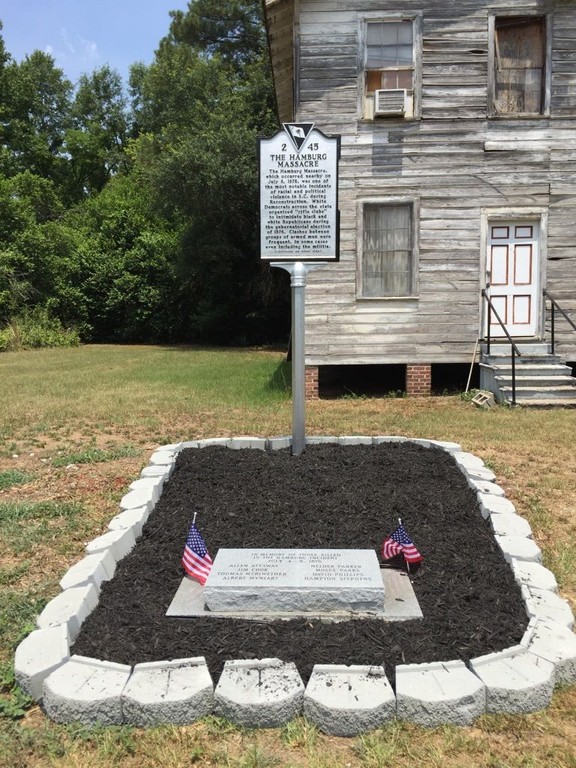
Roses were laid on the monument during its unveiling on March 6, 2016
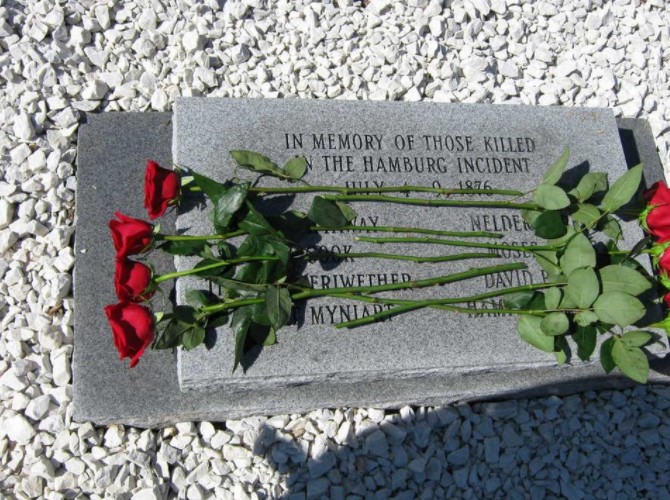
Front of Hamburg Massacre marker
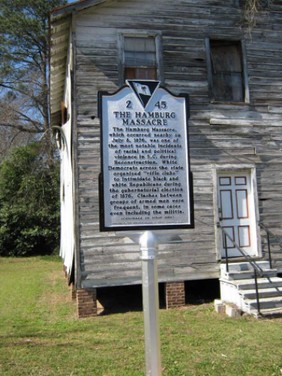
Back of historical marker
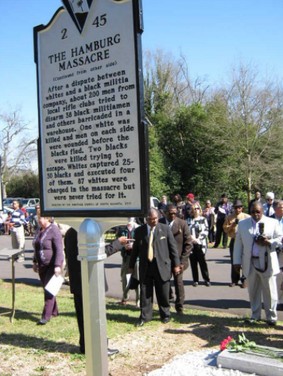
Dedication ceremony for the Hamburg Massacre monument, March 6, 2016
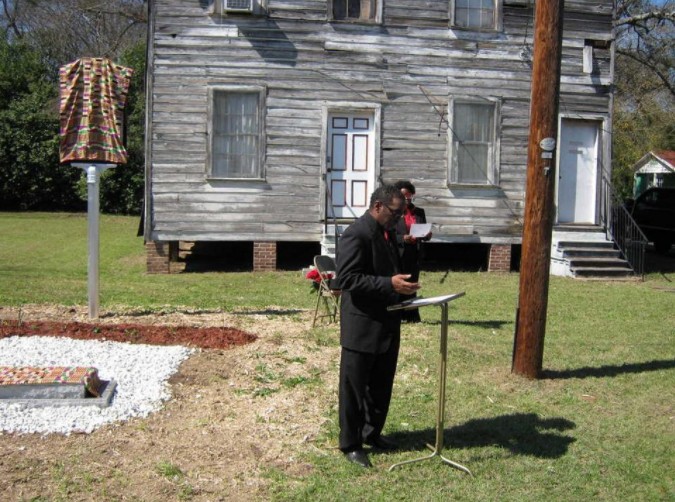
Dedication of marker, March 6, 2016
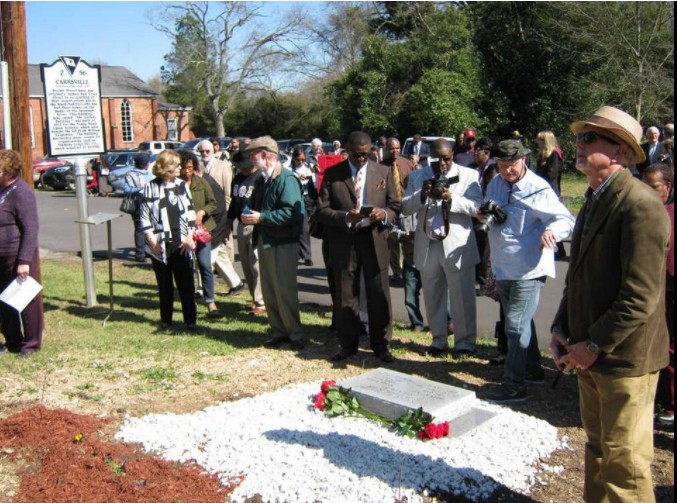
The historic location of the Hamburg Massacre is on the Savannah River where the bridges cross (Black square) and the monument is located at the red star.
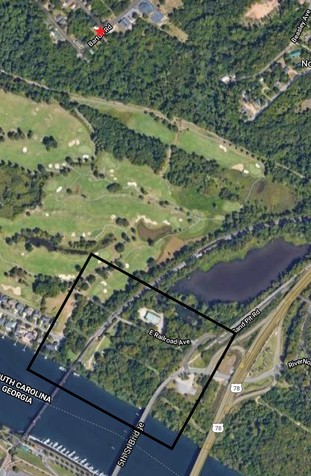
Map for the Hamburg Massacre (from Budiansky, The Bloody Shirt, p. 231)
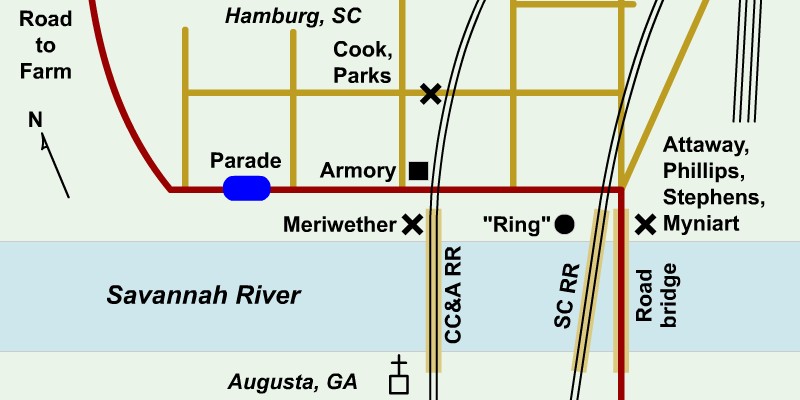
Location of Hamburg in 1921
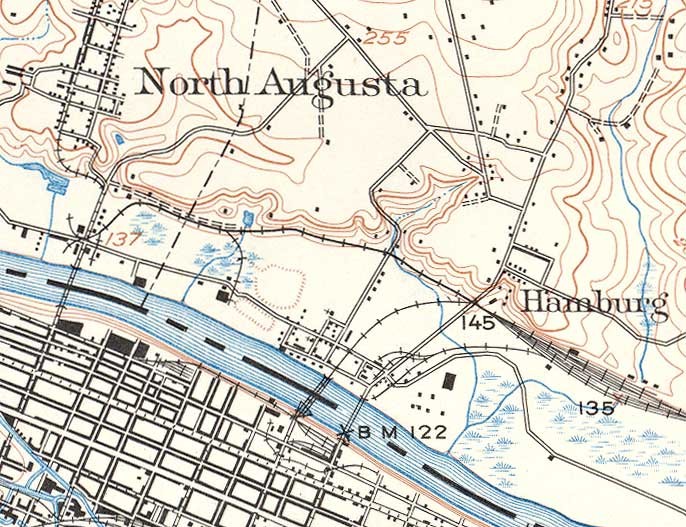
"The Hamburg Riot, July, 1876." Harper's Weekly, August 1, 1876.
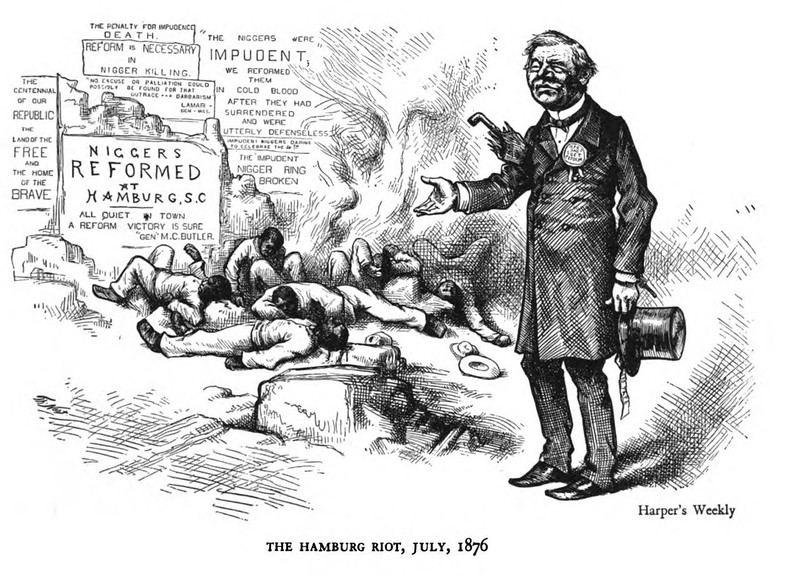
"Declaration of Equality" by Thomas Nast, July 1876
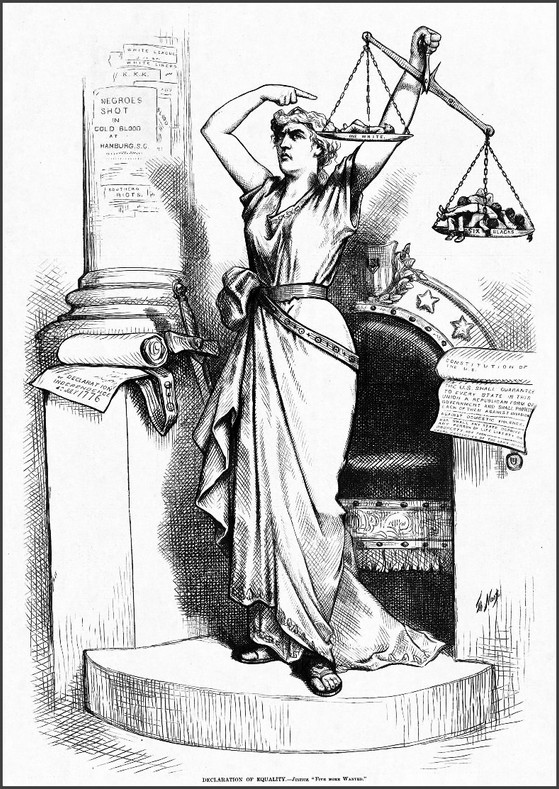
"Is this a republican form of govt?" by Thomas Nast, September 2, 1876.
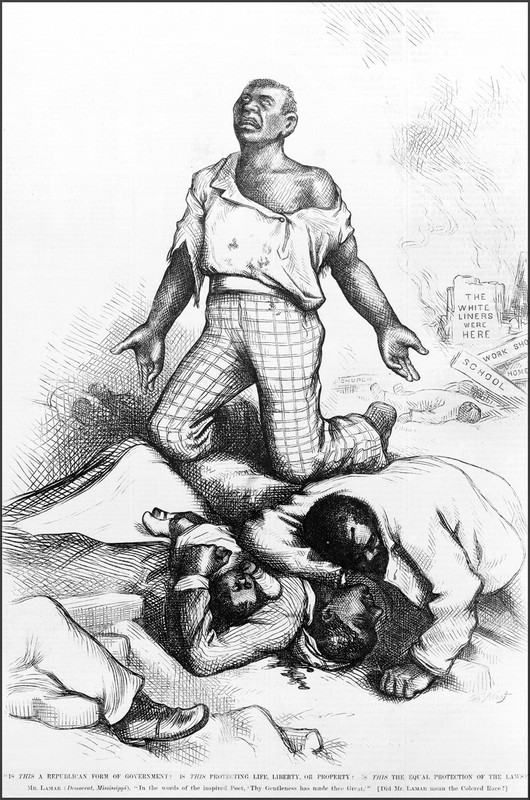
Backstory and Context
Text-to-speech Audio
From 1916 to 2016 the only monument commemorating the 1876 Hamburg Massacre was an obelisk for Thomas McKie Meriwether, the only white casualty of the violence. The obelisk was placed in Calhoun Park in North Augusta in 1916 by the state of South Carolina. In addition to only honoring the white casualty of the event, the obelisk uses language that is problematic in the twenty-first century. In order to balance the interpretation and commemoration of the event, this monument and accompanying marker were erected in 2016. The monument lists all eight casualties, including Meriwether.
The town of Hamburg no longer exists. After flooding in the 1920s most of the African American community relocated uphill to the Carrsville area. The Society Building at the location of the monument and the First Providence Baptist Church down the street are both consequences of the relocation, which is one reason the community placed the monument here. The historic location of Hamburg is closer to the river.
In 2019 the City Council evaluated the Meriwether Monument in Calhoun Park and options for adding/balancing the interpretation of the 1876 Hamburg Massacre within the community. The full report is linked below.
The 1876 Hamburg Massacre
After the Civil War the town of Hamburg was primarily a community of African American residents and the community organized a company of state militia. The unit was Company A, Ninth Regiment National Guard of the State of South Carolina and the men were armed by the state in their role as an organized militia. On July 4, 1876, to commemorate Independence Day, the company drilled under Captain Doc McAdams on one of the streets of Hamburg. Thomas Butler and Henry Getzen, two white farmers on their way through town, were outraged to find that the road was temporarily obstructed by the group of Black militia and a heated argument ensued. Captain McAdams finally ordered his men to part ranks to allow for the two men to travel through.
The next day Thomas Butler brought the matter up in court and charged the militia of obstruction of a public road, requesting a warrant against Doc McAdams. More to the point, he and other white residents and demanded that the militia be disbanded. While Augusta was primarily white and had several informal militias and rifle clubs, North Augusta was primarily Black and the existence of a militia consisting of Black Union veterans upset many white Augusta residents.
By July 8th hundreds of white men, many belonging to various rifle clubs, descended on the small town of Hamburg. Backed into a stone warehouse, the Sibley building, that also acted as an armory, 25 militia men along with 15 residents barricaded themselves in. When the force of white men outside the building started to fire, the militia within the building returned shots. During this firefight Thomas McKie Meriwether was killed by a shot to the head. Later the rifle club members brought out a cannon and reinforcements from Georgia and waited for the militia to run low on ammunition. Many of the African American men tried to escape from the armory building at this point. During his escape, the first Black militia member was killed; this was James Cook who was hit by 5-6 bullets as he tried to escape out the back of the building.
The force of white men took approximately 25 African American men prisoner as they tried to escape from the Sibley building. These militia men were placed within a ring of armed white men and several were picked out and killed. Allen T. Attaway, David Phillips, Albert Myniart, Moses Parks, and Hampton Stephens were shot to death after being picked out of the ring. Corporal Nelder John Parker was wounded by a shot to the back and died the next day. Three other men picked from the “ring” were shot but survived: Butler Edwards, Willis Davis, and Pompey Curry.
After a coroner’s inquest the judge in Hamburg issued 87 arrest warrants for white participants in the Hamburg Massacre, but none were convicted for their roles.
Cite This Entry
Thompson, Kathleen. "Hamburg Massacre Monument." Clio: Your Guide to History. April 9, 2021. Accessed September 19, 2025. https://theclio.com/entry/130362
Sources
"Meriwether Monument Committee Report to Council, Submitted by the Calhoun Park Committee." Accessed April 8, 2021. https://www.northaugusta.net/Home/ShowDocument?id=19760.
"Official Report of the Hamburg Massacre." Henry Shultz and his Town of Hamburg, SC: Economic War to the Death in the Antebellum South. Accessed April 9, 2021. https://henryshultz.wordpress.com/2015/02/23/official-report-of-the-hamburg-massacre/.
Aiken County Historical Museum. Facebook. July 12, 2016. Accessed April 8, 2021. https://www.facebook.com/aikencountymuseum/photos/a.253885277958848/1443700645643966/.
James Folker, "Black victims of 1876 Hamburg Massacre get historical marker." The Augusta Chronicle. March 6, 2016. Accessed April 9, 2021. https://www.augustachronicle.com/article/20160306/NEWS/303069934.
James Folker, "Black victims of 1876 Hamburg Massacre get historical marker." The Augusta Chronicle. March 6, 2016. Accessed April 9, 2021. https://www.augustachronicle.com/article/20160306/NEWS/303069934.
James Folker, "Black victims of 1876 Hamburg Massacre get historical marker." The Augusta Chronicle. March 6, 2016. Accessed April 9, 2021. https://www.augustachronicle.com/article/20160306/NEWS/303069934.
James Folker, "Black victims of 1876 Hamburg Massacre get historical marker." The Augusta Chronicle. March 6, 2016. Accessed April 9, 2021. https://www.augustachronicle.com/article/20160306/NEWS/303069934.
James Folker, "Black victims of 1876 Hamburg Massacre get historical marker." The Augusta Chronicle. March 6, 2016. Accessed April 9, 2021. https://www.augustachronicle.com/article/20160306/NEWS/303069934.
Google Maps. Accessed April 9, 2021. Edited by Kathleen Thompson.
"Hamburg Massacre." Wikipedia. Accessed April 9, 2021. https://en.wikipedia.org/wiki/Hamburg_massacre.
"Hamburg, Aiken County, South Carolina. Wikipedia. Accessed April 8, 2021. https://en.wikipedia.org/wiki/Hamburg,_Aiken_County,_South_Carolina.
"Hamburg Massacre." Wikipedia. Accessed April 9, 2021. https://en.wikipedia.org/wiki/Hamburg_massacre.
"Southern Reconstruction Thomas Nast cartoons." Accessed April 9, 2021. http://www.latinamericanstudies.org/reconstruction-nast.htm.
"Southern Reconstruction Thomas Nast cartoons." Accessed April 9, 2021. http://www.latinamericanstudies.org/reconstruction-nast.htm.

